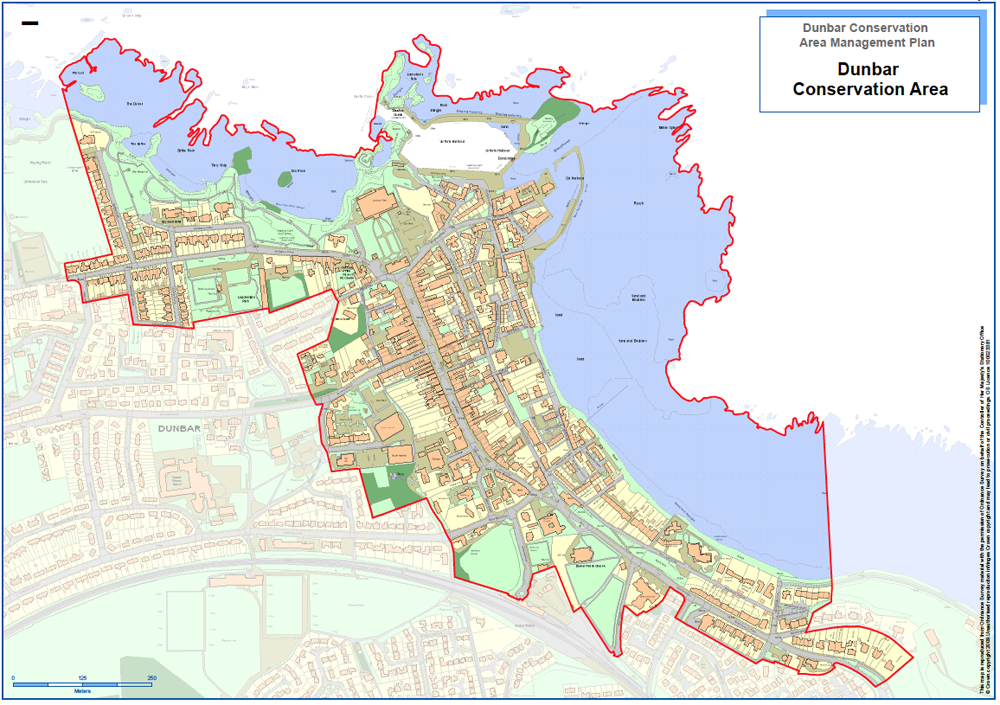Yes. Most of the older parts of Dunbar, though not all, are in the Dunbar Conservation Area [1]
Dunbar has one of 30 conservation areas in East Lothian, which sounds like quite an achievement, but there are 600 in Scotland. Planning authorities designate Conservation Areas in Scotland, which have a combination of special architectural and historic interest. To see if you are included in the conservation areas you have to check one of the maps of the designated conservation areas, which are available on the East Lothian Council website. Conservation areas are designated under the Planning Listed Buildings and Conservation Areas (Scotland) Act 1997. While Government and Historic Environment Scotland support Conservation Areas in many ways, responsibility for designation and protection is pretty much a local matter. There is no central list for Scotland as a whole and HES have quite limited information.
Guidance on the Designation of Conservation Areas and Conservation Area Consent
National planning policy sets out that local authorities are expected to ensure that local development plans and supplementary guidance provide a framework for protecting and, where appropriate, enhancing all elements of the historic environment. In this regard, local planning authorities should designate and review existing and potential conservation areas and identify existing and proposed Article 4 Directions. This should be supported by Conservation Area Appraisals and Management. As part of this process, planning authorities are encouraged undertake a thorough appraisal of any area before designation to ensure that its character or appearance is understood.
Large parts of Dunbar are covered by an Article 4 Direction, which places more restricted controls on permitted development. Over the years some local authorities have made grants available for the enhancement of the character of their conservation areas. Scottish Ministers, on the advice of Historic Scotland, may make grants in respect of buildings of outstanding historic or architectural interest and in respect of the promotion, preservation or enhancement of conservation areas. It is a few years since Dunbar benefited, but there was an application pending from 2019 under the so called CARS initiative.
Moreover, where there is a combination of interests, umbrella partnerships for the management have been developed, for example, Townscape Heritage Initiatives match funded by the Heritage Lottery Fund. They tackle problem buildings but may also include provision for small grants to individual properties. In cities, repair assistance may be available from Heritage Trusts.
Further information on financial assistance for historic buildings is available in Historic Scotland’s publication Sources of Financial Help for Scotland’s Historic Buildings.
Development in a Conservation Area
Special attention must be paid to development proposals in Conservation Areas. Permitted development without planning permission in Conservation Areas is restricted. Permission is needed for minor works, including satellite dishes, replacing windows, changing the colour of a building, or for adding a garage, a conservatory, a garden shed, oil storage tanks, new porches, inserting roof lights, dormers, sun pipes, solar panels, chimneys, roof vents of any description, the erection of new walls and fences. Demolition also requires consent.
So, seek professional advice, before you get the sledge hammer out.
What if I would like to display a sign or advertisement on my property?
Planning authorities are responsible for control over the display of advertisements and other signs and notices. All advertisements must comply with a number of standard conditions. Although not all signs or advertisements require advertisement consent (this depends upon its purpose, its position on the building, the size of any lettering and whether or not it is illuminated), the advice of the planning authority should be sought before proceeding.
The council run a very helpful Development Management service, which is there to provide advice to anybody considering work on property, including:
- whether or not there is a need for planning permission
- what you need to submit in the application for planning permission
- the factors that are considered in determining whether the grant permission
Ring up the Duty Planner between 9am and 12 noon Tuesday and Thursday or send them an email environment@eastlothian.gov.uk.
Any work to trees or felling of trees within a Conservation Area is included. Here is a link to further information on trees.
(Note: current circumstances mean they are not taking telephone calls.)
Will my application be granted?
Here’s what the ELC website says:
“Decisions on planning applications must ensure that a conservation area’s special architectural or historic character is preserved or enhanced.
Proposals detrimental to the character and appearance of a conservation area will not be supported.”
What may be surprising however is that rather few proposals are ever refused, though this could be due to very effective planning advice leading to applications that would probably fail being withdrawn; though some simply end up as “not determined”; while other so-called minor developments (as described above) simply happen without any reference whatsoever to planning. Spot how many satellite dishes you can see from your window, a great game to play with your children.
Planning Officers make recommendations to their Planning Committee, which is made up of local elected members, who don’t always heed the advice of their officers and may grant permission anyway.
[1. As someone has helpfully pointed out, much of new Dunbar, for want of a better word, is excluded. Arguably more perhaps most of Dunbar and its environs could have been designated. The area from West Barns to Belhaven (both designated) and over the mainline railway line including most of the Lochend estate grounds, and not forgetting the Deer Park and Broxmouth Park are of intrinsic historical and architectural interest. Dotted through the mature woodlands of Lochend are a number of important vestiges of the old estate (and some are afforded a listing status). The perimeter trees and the old Lochend estate walls, which add so much distinctive character to that part of Dunbar ought to receive recognition and better protection, which would justify investment in their maintenance.]
